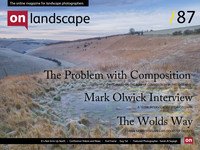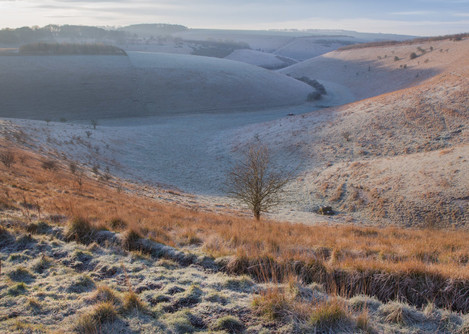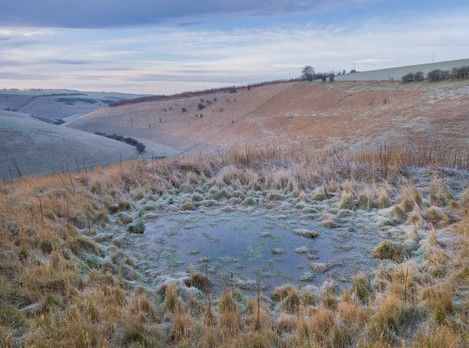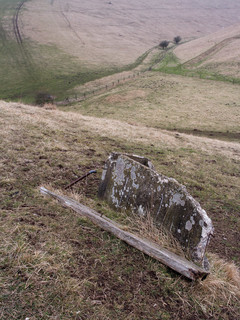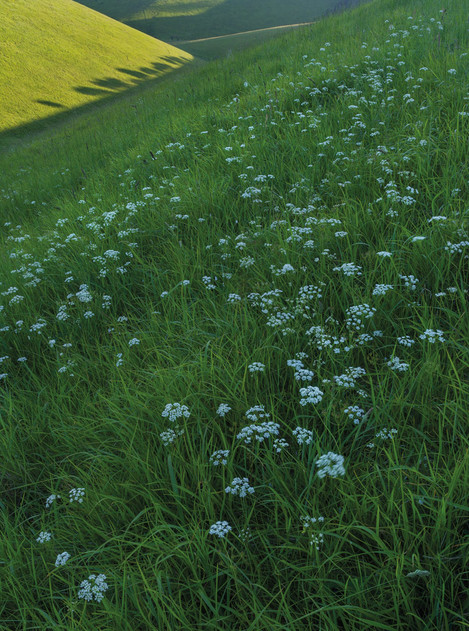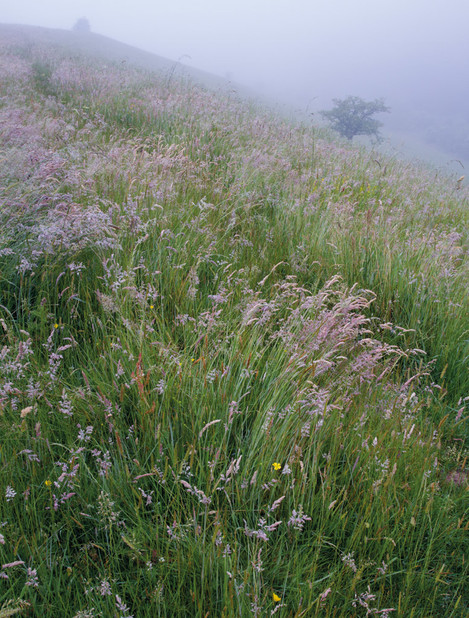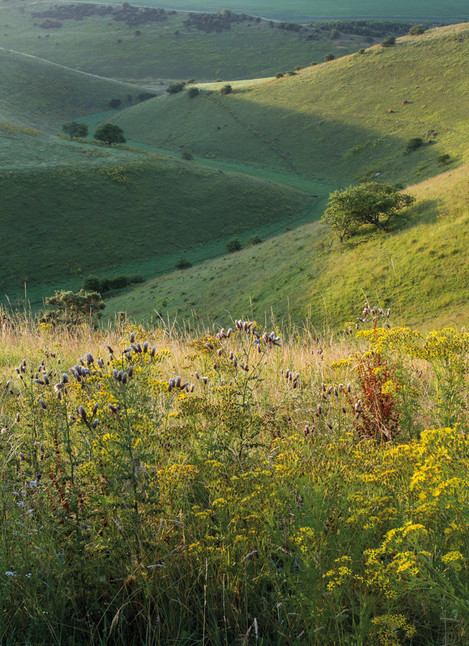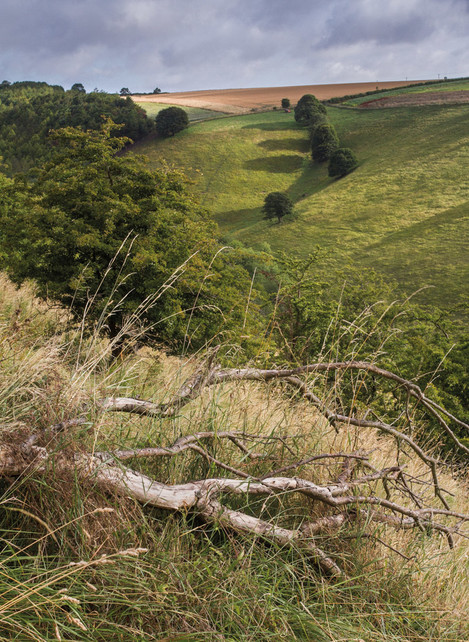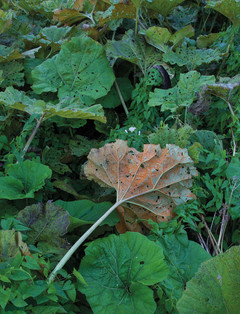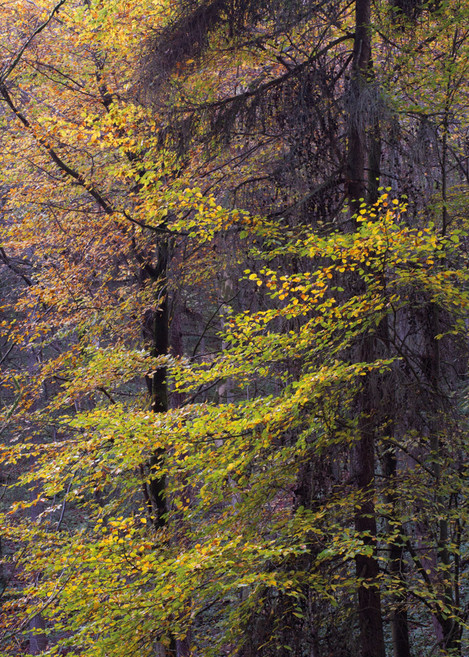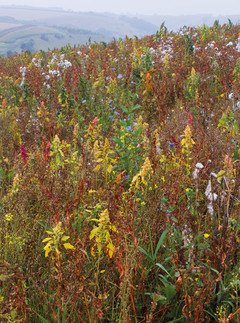Paul talks about his relationship with the Yorkshire Wolds

Tim Parkin
Amateur Photographer who plays with big cameras and film when in between digital photographs.

Paul Moon
Paul Moon is a landscape photographer from East Yorkshire and has spent 18 years documenting the Yorkshire Wolds - the UK's most northerly mainland chalk upland. It is known for its steep sided dry chalk dales which spread for miles throughout the area.
(narrative transcribed from a recorded interview which can be viewed at the bottom of the page)
###
Tim: Hello and welcome to On Landscape and I am sitting here with Paul Moon. We are going to be talking to tonight about your relationship with the Yorkshire Wolds.
Paul: Thanks, Tim. It’s nice to be here, despite the long drive; all of one mile.
Tim: Yes, since my move to the Yorkshire Wolds, we have been quite a bit closer, even though I don’t get out to a huge amount of photography myself. Although, we have been out together in the Yorkshire Wolds before I moved up here, a few years ago when you were posting to Flickr regularly. But you’ve stopped posting on Flickr?
Paul: Yes, I spent ten years photographing the Wolds. The first few years, I was getting used to the place, understanding how to use the camera, and I would occasionally get good results. I started going on to Flickr, using it regularly to make contacts with some great photographers, seeing the work they were producing. They would encourage me, and there was a great complement of photographers whose work I was very impressed with and gradually I built up a portfolio of work that I could post.
After four years or so, I became disillusioned with it. It isn’t the other people, but I felt that I was doing justice to the landscape, because I would post images from a couple of hours out with the camera at the weekend, but I wasn’t really showing what was out there to be seen. There would be one or two disconnected images from different locations and times of day, and they wouldn’t actually show what the area was like in a cohesive way, it was just showing what I had been up to at the weekend. In the end I wasn’t satisfied with it and I felt that it was showing what I wanted it to.
Tim: Like a diary, but with no particular purpose?
Paul: Yes, you are writing sentences, but you aren’t telling a story. I found that a lot of other photographers would try different things, experiment, but I’m an old school documentary photographer, and I try to replicate the world as closely as possible. I don’t like stylised, or black and white images, and so I found all the other influences on Flickr confusing and I kept questioning myself, whether I should change my style and so on. In the end I became completely confused about what I was trying to say, and what I should be saying, so I thought that I would take some time off from Flickr, see how it goes. To be honest I have enjoyed my time away. Although I have posted an image from time to time, I am now shooting for myself, not trying to please an audience of Flickr.
Tim: Were you consciously being influenced by the people on Flickr, and thinking that you had to make an image for that audience?
Paul: It is constantly at the back of your mind that there’s an audience and you wonder what they are going to say as you make an image…
Tim: A sort of performance anxiety?
Paul: Yes, that type of thing. I felt that I wasn’t being true to myself. That questioning voice made me want to take a break, and go back to how I had always worked, making images that I wanted to take without the influence of others.
Tim: Did things change when you stopped?
Paul: I found that I was enjoying my photography more. I didn’t worry about what other people thought. I felt that if I liked it, did anyone else need to? I wasn’t driven by the need to please others. Obviously commercially you have to please a viewer, and I do sell a lot of greetings cards around the Wolds, and I have a large selection of cards that are selling, but over the last two years, I’ve had very little that I could actually put on the cards to sell, because I’ve been making images that I wanted to take, without pandering to a market. I think it was a good move, but time will tell whether it has paid off or not.
Tim: We had a conversation about the cult of a single photograph, and whether we as photographers should be working towards a longer goal, rather than trying to make single successful images.
Paul: We spoke a few years ago about whether I should make a book about an area of the Wolds, find a book’s worth of images from a small area. It would take too long to photograph the whole of the Wolds, it’s a big area. That would be a lifetime’s worth of work. The place that came to mind was Millington Pastures. It’s a valley system, opening up in to the Vale of York. Millington Pastures itself is where a large valley has been created, with other small valleys branching off, in a typical fractal system. The valley where Millington village sits is the main trunk of that system. Each of the smaller valleys has its own ecosystem and environment that is different in style and topography.
Tim: It’s only a couple of miles across…
Paul: Yes, if you walk from Millington, it’s only three miles to the furthest part of the Pastures, and it’s probably about a mile across. So, it’s only three square miles of landscape. There’s a lot to explore though.
This first image was taken in January last year. It shows one of the tributaries of the main valley of Millington Dale, Frendal Dale curving around. Melt waters from snow and ice of the last ice age, probably a mile in depth, melted and poured though the chalk and cut these river beds in to the earth. This little part of Frendal Dale is tributary and joins the main dale. It’s very smooth, and the Wolds Way is there in the background. What’s great about is that the interlocking spurs actually join the Wolds Way there as well, giving a lovely zigzag shape. A lot of the time, you won’t see dawn light here, because you’re on a plateau here on the Wolds and then this is in a valley. You only start to get light about half an hour after sunrise. In winter, this frost stays all day because the sun doesn’t get high enough to warm those parts of the valley and they are in permanent shade.
Tim: Is there any water in there?
Paul: No, they’re dry valleys. There are some springs further along in to Millington Dale, but once the ice age was over, the ground was permeable and so any rain that falls just soaks in to the valley chalk. It’s grass land, but you can’t farm it with ploughs. It’s open access land and so you can walk all across it. People tend to walk down through the valleys and out the other side, but I tend to walk around the tops, up and down the slopes, because you get great views from the sides and the tops of the valleys. Low down, you don’t, you just see the v shapes. I don’t have the luxury of mountains or distant fjords stretching away, foregrounds are difficult because there aren’t any rocks. Occasionally I might find some chalk or flint, but you can’t put it in the frame because it isn’t pretty enough. You have to think differently about how you are going to frame the landscape.
Tim: I should mention that part of what you do is that you work for a printing company and do graphic design as well. That sensibility is quite strong in some of the pictures of yours I have seen.
Paul: Again, something I have picked up through graphic design is the desire to find very simple, graphic shapes, and compositions. This place is ideal for it. It isn’t a complicated place. It lends itself to simple geometric shapes in your photographs.
This image was taken early in the morning, and this very orange grass is caused by the sun melting the frost on it and then it catches the lovely warm light. It looks very vibrant, but this is how it is. I’m not super-saturating it. I sometimes can’t believe the colours when it is frosty. It’s not something you often see.
Tim: Next picture?
Paul: This was taken on the same morning in softer light, so the sun has gone behind the clouds. I prefer this one to the first as it is much softer and there is the nice reflective blue in the pond that ties in nicely with the oranges in the grasses around the edge of it.
Tim: This a dew pond that farmers used to make to allow their livestock to drink…
Paul: Yes, this isn’t used anymore, it’s fenced in and is just part of the landscape.
Tim: The drainage is so good in the area that the farmers would have to pack the bottom of these with limestone, or clay to keep them from drying out.
Paul: Yes. There was a little chap who used to go around and fill these in during summer when they had dried out. He used to go around with his limestone and fill the bottoms out. They are all over the Wolds, especially in these little pockets where the grazing areas are. You can see the little circles of these dew ponds all over the place in the landscape, although many of them are dry these days. So this image tells a nice story of the area, and I’m not too bothered about the telegraph poles in the distance. This isn’t a natural landscape, it’s a farmed landscape, but there are natural elements within it. I try to exploit those natural elements, but I’m not scared that there are man-made items and artefacts in that landscape, and for me it doesn’t spoil the landscape. This is England and we can’t avoid it. I’m happy to show fences, barbed wire and the like and they don’t bother me.
Tim: So how much of the Millington area is open access?
Paul: Most of it. There are odd pockets where some farmers have blocked off areas where they want to keep cattle, so unless you jump over fences, you can’t get to it. There’s the odd woodland where it has been blocked off again, but nearly all of it is open access land. It’s fantastic that anyone is free to walk around this place and not get harassed.
Tim: Presumably it’s because it is too steep to do any agriculture of any sort and it’s an almost upside-down landscape?
Paul: In the Lakes, the cattle and grazing are on the hillsides, and the arable land is in the valley bottoms. Here it is completely opposite. The arable land is on the hillsides where they will plant barley and wheat on the tops, but within the valleys there is the grazing because of the steepness of the slopes. The landowners are responsible, they try to encourage the wildlife. They have cut down a lot of the Hawthorns to help the grazing, but they have left a few so that they don’t totally decimate the hawthorn and to keep the balance of nature. They do look after it, trying to encourage the wildlife, and so there’s a good relationship between the farmers and the land.
This next image is completely different to the first two shots. It has drab conditions, with no light, no drama, it’s just an old concrete trough that has been left to crumble in to this little pillar of concrete. It’s not something that would grab everyone’s attention on Flickr. I’ve been here several times and made different images of this place, but there’s something about this one that appeals to me. This was taken in March, so everything is in stasis, there’s nothing growing, although there is always a little trail of green in the bottom of the valleys, because the ground is different at the bottom. On the hillside there, the soil is very thin, but down the bottom there is plenty of soft soil for the moles to dig through. There’s even the remnants of a dew pond there, with the little rise where it has been built up. In the distance there is a prehistoric earthworks, fences, barbed wire, and then this concrete trough with this lovely lichen on it. What appeals to me about this shot is the contrast between the lichen and the hard concrete.
I think the farmers used to run pipes and hoses down in to these valleys, as you can even see in the first shot, but these have become unused and part of the landscape now. This trough is my equivalent of the Joe Cornish boulder because I’m desperate for some foreground interest. You can see that the background is very soft, but I love it. It’s the context though for the image and so I love it. It’s about soft colours and the main feature for me is the trough, so I don’t mind. If it was a mountain, I’d probably need it to be sharp, but because it is just shapes and colours and tones, I’m not worried that it isn’t super sharp.
This is a very drab, melancholy image. There’s no great light, but it’s about the English landscape in any weather, at any time of day and time of year. We don’t have brilliant photographic weather all year, but why should that stop us going out and taking photographs? I love being out in any weather and I love the atmosphere of it. It’s very quiet and peaceful and I am trying to reflect that it the photograph.
This next image is a complete contrast again. We’ve gone from the frost cool blues with oranges to vivid greens, that are very bright. This is taken in June, so once the grasses start to grow, they will keep growing, even without rain, and they go mad.
Tim: Is this Pignut?
Paul: Yes, this little collection of flowers is Pignut. It’s a sign of mature grass land. There’s a little tuber that grows underneath these that people used to harvest and eat, a bit like a chestnut. That’s part of the story, but the other part is what’s happening in the distance.
Tim: A lot of people can’t cope with mid-summer weather, but because of the deep valleys you have wonderful shadows and there’s always something interesting going on…
Paul: Well this is early evening, about 7 o’clock on a June evening. You can already see that there’s shade in this valley, and usually at this time of day in mid summer you wouldn’t expect shade.
Tim: It shows how steep the valleys are…
Paul: You’re looking at 40 to 45 degrees on some of them, and occasionally even steeper. These hawthorn trees are left to mature, and you get a lovely little line of shadows wandering along the side of the valley. I don’t mind working in light like this, because I know that it’ll create shadows like these, and it allows you to balance the strong light with deep shade.
This next image is later in the season when the grasses are seeding. It’s stunning. What you don’t see is that although the grass seed heads are white when they are dry, when they get wet they turn wonderful shades of pink and magenta. This valley is Pasture Dale. Occasionally, even in summer you can get a mist and it’ll sit in the valleys. That dampness has caused the grass to be wet and you can even make out the droplets of dew in there. I always like to compose this way, with opposite directions of flow within the image. This isn’t grazed valley, so that’s what leaves this grass pristine and mature, with all sorts of varieties. Lots of wild flowers, buttercups. The mist helps with the soft light and it recedes in to the distance.
In late summer, you get a lot of different flowers. In early summer you can have Cow Parsley, Poppies, Buttercups, Pignut, but then in July and August, there are Ragwort, Harebells, Scabius, Clover, Ladies Bedstraw. Last year, there were hardly any wild flowers here, but this year there were carpets of flowers. The whole of this side of the valley was blue with flowers. What I like most about this is the little spurt of red from this little dock in the foreground, and some nice shapes made by the grasses in the bottom. The key though is the light that just starts streaming in at this time of day.
Tim: The thing that struck me when we went out is how quick you have to be because the light and shadows moves very fast around here.
Paul: Yes, because within twenty minutes the light hits the bottom of the valleys, but then the light hits the opposite side of the edges of the valleys and you get shadows down the sides of the valleys as the sun gets higher. By the time we get to the next image, which was taken two hours later, the sun has started to rise above the edge of the valley and it casts long shadows down the side of the valley.
Again this image is taken in late summer and the green is disappearing out of the grass. They are bleached and skeletal. I spent about an hour here waiting for the right combination of light in the foreground and in the distance. I don’t spend a lot of time waiting around for light, but in this case I felt that it needed me to spend some time waiting for it to happen. The main part of the image is the circle of trees and their shadows, and they are encroaching in to the centre of the frame, and not on the thirds, but I don’t mind that at all. What I wanted to show was the light and how the shadows interact with each other and are different. The shapes of the valleys have let the light and the shade create this dual shading, and it takes a while to find it, but every now and then it appears.
My next image is more of an intimate detail type shot. I wasn’t interested in only showing the wider landscape. I wanted to show what was in the landscape and what makes up the landscape. Details are a part of what I see and what I like to photograph. This is pure roadside photography. My tripod legs are probably actually on the road.
Tim: You’ve got a slug problem there, haven’t you?
Paul: That’s a big slug, that one! This is Butterbur. It grows in damp conditions, and in this valley there are streams and ponds and marshes, so throughout the year the Butterbur grows. In late summer, when this image was taken, it has just started to die, and it’s obviously the fractals that caught my eye and the rust fungus, creating great contrast between the oranges and the greens. I like the details and the tendrils of the bindweed moving through the image, filling the space in this decaying landscape. They’re coming alive whilst everything around them is dying, twisting and turning through the complexity of these leaves. Would I get an explore on Flickr for that one? I don’t care. I just like it for how it is. People want to travel the world and see this and that; I just want to see a Butterbur in Millington Pastures, lying on its back with some rust on it. I’m just happy that we can see these things in this country, and they’re just five miles up the road from me.
These things are exotic, but we’ve grown up with it and see it everywhere and so we are so used to it, we look at it with blinkered eyes. I’m trying to look deeper in to the English landscape and find more. Especially when it comes to plants. A lot of the work that I do is about plants. I don’t have rocks, I don’t have water, I don’t have mountains, I don’t have lakes, so what else can I use? There is some woodland, which ties us nicely in to the next shot.
This is Millington woods in November of 2013. It was quite a late autumn and I think you were standing right next to me at the time. This images is all about the flow and the way things rise and twist around the frame. Does it fall or does it rise? What’s it actually doing”
Tim: The beauty, I think, about Millington Woods is that you have this valley like we have seen before, with steep slopes…
Paul: Yes, you’re in the canopy. You can walk up a little way in to a position where you are in the canopy, and you are looking through.
Tim: I can’t think of many situations where you get a wood like that.
Paul: Parts of this wood aren’t easy to photograph as they clear the scrappy Ash from it. There are a lot of saplings, a charcoal kiln, Larch. There are parts of the wood where it has been left to grown naturally. I try to find these parts and try to find the best way to show them. This might get a few favourites of Flickr, and I’m not averse to making images that people will like looking at, but I’m really trying to show every aspect of this landscape, including the woodlands.
Tim: One of the things I like about your photography is that you are an equal opportunities season photographer.
Paul: Yes, I’m keen on all seasons. There’s no point in shutting yourself away at certain times of the year and complaining that it’s too bright, or too wet, or there’s too much colour, not enough colour. I’ll shoot at any time of the year, as long as I can make it work.
Tim: Your working practice is that you try to get out at least once a week…
Paul: Yes, once a week. If I can get out on a summer evening, it’s nice to get out for a few hours during the week, but otherwise I try to get out at the weekends. The first four years, I was on my own, but after that I got in touch with another photographer, John Brock, and we used to go out nearly every other weekend for two or three years. We spent a lot of time exploring different parts of the Wolds together. He’s a technician par excellence, John. He didn’t teach me, but I learnt things by watching him. After a number of months, I got to work out what I wanted to do, work out the finer points of balance and colour in composition, that John is very good at. Over the last two years though, he has been very busy and I haven’t seen much of him, so I’ve had to get out and do it on my own. I’ve enjoyed being on my own, because when you are out with people you are often distracted, worrying about the shot they’ve taken, that you’ve missed, and you aren’t concentrating on enjoying yourself and what you are doing yourself.
Tim: It’s great going out with other people, I don’t create great work when I go out with others, but you do pick up things. You learn things.
Paul: And it’s great to interact with other photographers.
Tim: I can tell when I go out with you though that you are simply excited by where you are and showing it to people. It shows your passion for the area.
Paul: I’m so excited by it, and I want to show people this landscape. It’s not seen by many; The photographic press just aren’t interested. I spent five years buying Outdoor Photographer, and if I had seen a picture of the Wolds, I’d have passed out. I didn’t even see one. Nobody knew it was there, and it doesn’t attract tourists.
Tim: How did you feel when David Hockney had his spate of successful exhibitions about it?
Paul: It was great because it started to get the publicity that it deserves. It didn’t show the Wolds like I see them, he only scratched the surface, looking at the open arable land. He found it easier to paint that and some woodland. He said it’s a difficult place to photograph, saying that you can’t photograph the Wolds. I agree that the tops and the arable land is very difficult to show and photograph, but in these valleys there are little pockets with so much interest. There are countless things you can photograph, so I don’t think he’s right in saying that you can’t photograph the Wolds, but you do have to know how to. It was important that he gained some publicity, but he doesn’t tell the whole story.
This image is slightly different. Taken about three weeks ago. It was a muted, damp and misty day. Around the edges of the valleys the farmers plant what is called Bird Mix. It’s either designed to grow so that pheasant, grouse and partridge can hide in. There are all sorts of different types of mixes of things, like sunflowers, chicory, and others. This is Quinoa, the superfood, and they’ve planted the mix to encourage wild birds and the like. I came across this and though that I would have to take a photograph of it, with the bright yellow and bright pinks, oranges. They’re the most vivid colours you’ll ever see whilst walking the countryside. I couldn’t resist making an image of it. This image is all about colour, texture, shape and the story, and I don’t mind that there is some movement in it. It’s there and it’s growing, and it’s part of what makes Millington Pastures what it is.
Tim: Do you feel like you’re reaching some sort of conclusion with your Millington project?
Paul: I am. I was getting to a point where I wondered what else I could do. I’ve got pictures of all the valleys in snow, frost, sunlight, miserable British weather. I’ve got the full range, but I still go out and I’m still finding something new to this day.
Tim: Do you think it will finish? Do you think that this something that you will feel that you’ll be able to do something with, like make a book?
Paul: I’ve got some images that are quite old, and whether they need to be replaced with newer images, I’m not sure. I don’t dislike the older images, but whether they need to be improved upon is the thing. Do I keep trying to improve on things I’ve done before. A lot of photographers keep going back to the same places hoping that what they have done before can be improved upon and can be bettered, so that they end up with an even better portfolio. I would say that I’m nearly there, but there will come a point when I feel that I want to do something else. I’m starting to get itchy feet now, and I know there are other projects elsewhere. So perhaps I’ll start something else soon. It’s debateable whether I’ve finished or not, so I’ll just leave it open for now.
###
- Orange and blue
- Dew pond
- Trough
- Tree shadows
- Shadows
- Grasses and mist
- Scoardale autumn sunlight
- Sandoval Quinoa
- Butterburr leaves
- Beech leaves
A big thanks to Paul!
You can view the interview below as Paul talks Tim through the images. In the meantime you can see more of Paul's work here:
http://www.paulmoonphotography.co.uk

